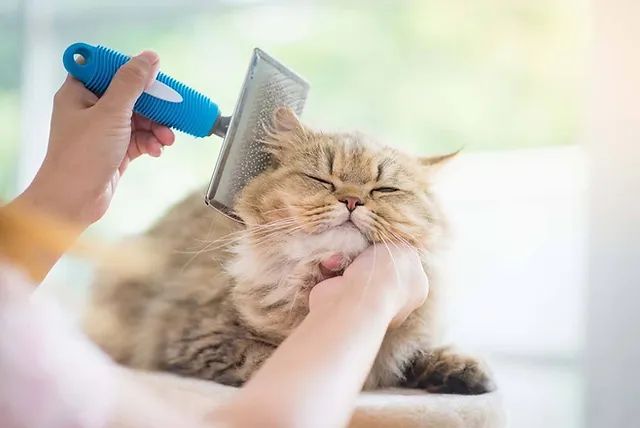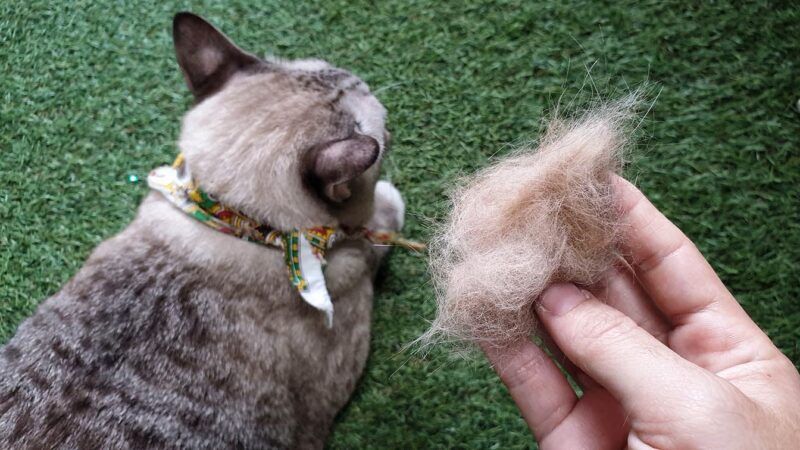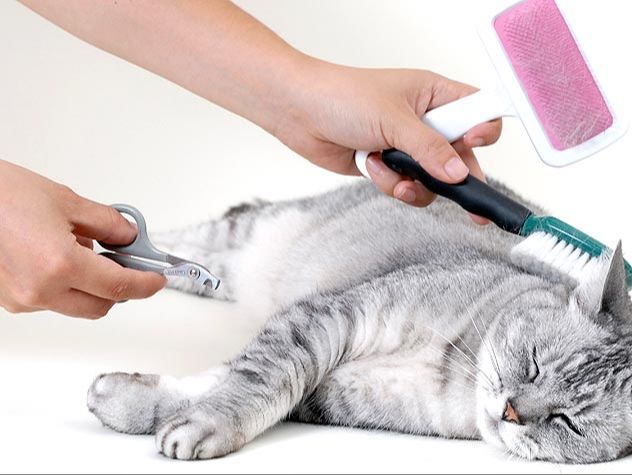Understand Why Cats Shed
All cats shed to some degree as part of their natural hair growth cycles. Typically, cats will shed more of their undercoat in the spring and fall as the seasons change and the temperature fluctuates. This helps them regulate their body temperature and adapt their coat for warmer or cooler weather. The shedding is usually most noticeable during these seasonal changes.
Genetics also play a big role in how much cats shed. Breeds like Siamese and Rex cats have very fine, short hair and tend to shed less. Long-haired breeds like Maine Coons and Persians have thicker, longer coats that require more regular grooming and shedding. Dander production and hair length are intrinsic to a cat’s genetic makeup.
While shedding is a normal part of a cat’s hair cycle, excessive shedding can sometimes indicate an underlying medical issue. Conditions like allergies, hormonal imbalances, stress, and skin parasites can all lead to increased shedding. Checking with a veterinarian can help rule out any health problems if shedding seems abnormally heavy.
Brush Your Cat Frequently

Regular brushing is one of the most effective ways to reduce shedding in cats. Investing in a good cat brush and taking the time to brush frequently can make a big difference.
The best brushes for reducing shedding are slicker brushes and dematting combs. Slicker brushes are ideal for removing dead hair from the undercoat, while dematting combs help detangle and work out mats and knots.
When brushing your cat, be gentle and take your time. Focus on areas prone to tangles like the belly, behind the legs, and base of the tail. Brush in the direction of hair growth and don’t press too hard. Give your cat treats during brushing to reward good behavior.
Brushing your cat daily or every other day has multiple benefits. It removes loose hair before it can be shed all over your home. Regular brushing also helps distribute skin oils along the hair shaft to promote a healthy coat. For long-haired cats especially, daily brushing can prevent mats from forming.
While brushing requires an investment of time, it’s a simple and effective way to manage shedding with minimal effort or expense. By making brushing a consistent part of your cat’s routine, you can significantly reduce loose hair and keep your cat’s coat healthy and shiny.
Bathe Your Cat Occasionally
Bathing your cat every 4-6 weeks can help reduce shedding. The bath will wash away loose hair and refresh the coat. However, it’s important not to bathe cats too frequently, as over-bathing can dry out the skin and fur. Only bathe when your cat is shedding excessively.
When bathing your cat, use a gentle, moisturizing cat shampoo and lukewarm water. Avoid getting water in your cat’s ears and eyes. Gently massage the shampoo into the coat and rinse thoroughly. Follow up with a cat-safe conditioner to keep the coat glossy. Towel dry, then use a blow dryer on a low, cool setting. Reward your cat with treats afterwards.

An occasional bath rinses away dead hair and distributes natural oils through the fur for a healthy coat. It also removes allergens and dirt from the skin and fur. A clean coat sheds less and tangles less. Just be sure not to overdo bathing, as too frequent baths can cause dry, irritated skin.
Consider Dietary Changes
What a cat eats can have a big influence on how much they shed. This is because poor quality diets or missing nutrients can negatively impact skin and coat health. The best cat foods for reducing shedding are high in omega-3 and omega-6 fatty acids, which help support a healthy skin barrier and reduce inflammation that can cause excess shedding.
Some top foods recommended by vets and cat nutritionists include Hill’s Science Diet Adult Indoor Cat Food, Purina Pro Plan Focus Sensitive Skin & Stomach Salmon & Rice Formula, and Blue Buffalo Wilderness High Protein Grain Free. These provide balanced nutrition with higher quality ingredients compared to grocery store brands.
Avoid cat foods with fillers like corn, wheat, soy, artificial colors/flavors. These offer less nutritional value and can exacerbate allergies that lead to excess shedding. Also skip fish heavy foods which are high in mercury – moderate fish content is okay.
Try Supplements
Certain supplements may help reduce shedding in cats by improving skin and coat health. Some options to consider include:

- Omega-3 fatty acids – Fish oil supplements provide omega-3s like EPA and DHA which can reduce inflammation and support skin and coat health. Studies show omega-3s may reduce shedding in cats (1).
- Vitamin supplements – Vitamins like vitamin E, vitamin C and B-complex provide antioxidants and nutrients for skin and coat. Vitamin deficiencies can cause excess shedding.
- Multivitamins – Broad multivitamin supplements provide a blend of vitamins, minerals and nutrients to support overall health and reduce shedding.
When giving supplements, follow dosage guidelines on the product. For fish oil, typical dosage is 100-300 mg combined EPA and DHA per 10 lbs body weight daily. Give other supplements as directed, starting with lower doses. Check with your vet before giving any new supplement.
While generally safe, too high doses of some supplements can cause toxicity. It’s also best to give supplements with food to avoid stomach upset. Monitor your cat and discontinue use if any negative side effects occur.
(1) https://www.amazon.com/Shed-X-Liquid-Daily-Supplement-Cats/dp/B0001RT508
Use Deshedding Tools
Deshedding tools like combs and gloves can be very effective at removing dead hair and reducing shedding. Some popular options include:

- Deshedding combs – These have fine, sharp teeth that reach deep into the coat to remove loose hairs. The FURminator deShedding Tool is a top choice.
- Deshedding gloves – You pet your cat with these special rubber gloves to gently remove loose fur. The Pat Your Pet grooming glove is a good option.
- Lint rollers – These can remove hair from your home and clothes in between full grooming sessions.
When using deshedding tools, go slowly and gently to avoid irritating your cat’s skin. Focus on areas where loose hair collects, like the belly, back, and behind the legs. Avoid using the tools too harshly or too often, as they can damage the coat if overused. Aim for once or twice a week for short-haired cats, and 1-3 times a week for long-haired cats.
Consider Shaving/Trimming
Shaving or trimming your cat’s fur is an option to help reduce shedding, but there are some pros and cons to consider.
On the pro side, shaving will remove a lot of loose, dead hair that would otherwise end up shed around your home. It can be an effective way to manage heavy shedding seasons like spring and fall. Shaving may also keep your cat cooler in hot summer weather.
However, there are some downsides as well. Shaving can damage or alter the coat texture, especially for long-haired breeds. It may also make the coat grow back improperly. Shaving may increase dander production and cause skin irritation for some cats. It does not stop shedding entirely, as cats will still shed shorter hairs.
If you do choose to shave your cat, be very careful and take precautions. Avoid shaving too close, never shave against the direction of hair growth, and use clippers designed specifically for pets. Only shave small areas at a time to avoid nicking their skin. Never shave a matted coat, and don’t shave elderly or sick cats.
In general, shaving once or twice a year during heavy shedding seasons is sufficient. Speak to your vet first, especially if your cat has medical issues affecting their skin or coat.
While shaving can help temporarily reduce shedding, it does not address the underlying cause. Combining shaving with other methods like regular brushing, bathing, diet changes, and deshedding tools will provide better long-term relief from excessive shedding.
Vacuum Regularly
Regular vacuuming is one of the most effective ways to manage cat hair around your home. Upright vacuums, canister vacuums, stick vacuums, and even handheld vacuums can all help remove cat hair from carpets, hard floors, furniture, and other surfaces.
Focus on frequently used areas and fabrics that attract cat hair like carpets, couches, beds, and cat trees. When vacuuming carpets, make several slow passes back and forth to lift all the hair up from the base of the fibers. Use attachments like crevice tools, brush heads, and motorized pet hair removers to clean corners, baseboards, furniture, and stairs.
For best results, vacuum at least 2-3 times per week in rooms your cat frequents. You may need to vacuum daily during peak shedding seasons. Empty the vacuum after each use so hair does not clog the filter.
Reviews suggest upright vacuums like the Shark NV752 1 and canister vacuums like the Miele C3 Cat & Dog 2 excel at removing pet hair from carpets and furniture.
Use Lint Rollers
Lint rollers are an easy and effective way to quickly remove shed cat hair from furniture, clothes, and more. They work by using an adhesive sheet to grab onto loose hair as you roll it across surfaces.
There are a variety of lint roller brands and types available. Look for ones specifically designed for pet hair, as they will have stickier adhesive sheets to grab onto the hair. Popular options include the ChomChom Pet Hair Remover and the Evercare Magik Brush Lint Roller.
To use a lint roller effectively on cat hair, roll it across fabric surfaces in short strokes. Make sure to press down firmly to get the adhesive to grab onto the hair. Replace the adhesive sheet frequently as needed. Using a lint roller regularly will help reduce shed hair around your home.
See a Vet If Needed
It’s important to recognize when shedding requires a vet visit. If your cat’s shedding seems excessive or doesn’t respond to at-home remedies, it’s time to see the vet. Sudden onset of excessive shedding can indicate an underlying medical condition that needs treatment.
Some medical conditions that can cause increased shedding include:
- Allergies – Both food and environmental allergies can trigger excessive grooming and shedding in cats (source: https://www.zoetispetcare.com/blog/article/cat-shedding).
- Skin infections – Bacterial or fungal skin infections often lead to irritation, scratching, and fur loss (source: https://bondvet.com/b/ways-to-reduce-cat-shedding).
- Fleas – Flea infestations cause itching and overgrooming, resulting in clumps of shed fur (source: https://www.pumpkin.care/blog/why-is-my-cat-shedding-so-much/).
- Hormonal issues – Conditions like hyperthyroidism or Cushing’s disease affect hormone levels and can increase shedding (source: https://www.pumpkin.care/blog/why-is-my-cat-shedding-so-much/).
At the vet visit, the doctor will perform an exam, take the cat’s full medical history, and may run tests like skin scrapings, bloodwork or allergy tests. Treatment options depend on the underlying cause but may include medications, supplements, allergy shots, or special shampoos and conditioners.

